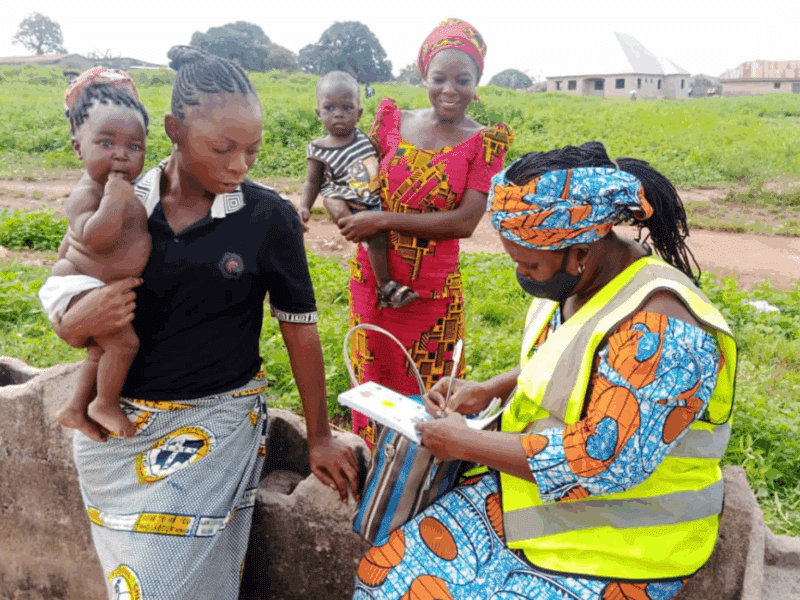In some parts of Africa, insecticide-treated mosquito nets designed to prevent malaria lose their effectiveness or are too torn to be protective after just two years, while in others they can last longer than the three years they are meant to be useful, new research suggests.
In a series of papers published in recent days and weeks by Malaria Journal, leaders of the Johns Hopkins Center for Communication Programs-led VectorWorks project looked at mosquito net durability in regions of three countries: Nigeria, Tanzania and the Democratic Republic of Congo (DRC).
“If nets are wearing out every two years and campaigns are done every three years, we will have more malaria because people won’t be protected,” says Hannah Koenker, PhD, who led the President’s Malaria Initiative (PMI)-funded VectorWorks project, which ended in September 2019.
Koenker and her colleagues found that whether nets protect people from malaria for three years – the standard time between mass distribution campaigns funded by international donors – depends on net care behaviors and attitudes that people have about the value of the nets.
Behaviors and attitudes vary from place to place. Nets were less likely to become damaged when they were tied up during the day, in households with fewer small children and where people felt they were able to take care of their net. Good care behavior could also prevent damage even in households with other risk factors, like more rudimentary housing that can cause snags and tears in nets.
“The behaviors really matter and the environment you’re in really matters,” she says.
Treated bed nets are thought to be responsible for the lion’s share of the reduction in malaria cases worldwide since 2000. In 2018, there were 228 million malaria cases that led to 405,000 deaths worldwide, according to the World Health Organization.
The papers are the first analyses conducted using a new durability monitoring protocol developed and standardized by the CCP VectorWorks team. Following mass net distributions in countries where malaria is endemic, teams of monitors tagged a cohort of nets and then followed them up at regular intervals to see how well the nets were holding up, whether they had holes that made them ineffective and whether the insecticide was still able to kill mosquitoes that carry the parasite that causes malaria.
For the papers, the researchers compared net durability in two to three different regions of the countries studied. In some cases, they compared regions that were culturally and geographically distinct and were using the same brand of net. In others, they compared similar districts using different brands of net. They found little difference between brands, but they found that nets simply lasted longer in some places than others.
In Nigeria, for example, the estimated survival in serviceable condition of the campaign nets after three years was 80 percent in Zamfara state and 55 percent in Ebonyi state. Nets that were used only by adults and nets in households where people reported hearing about net care messages and had a positive net care attitude tended to have longer average survival. These environmental and behavioral factors could increase the time until 50 percent of nets are no longer serviceable by up to two years, the researchers found.
In the northwestern part of the DRC, by contrast, after 31 months, only 37 percent of nets survived in serviceable condition in the Sud Ubangi region and just 17 percent survived in the Mongala region. Estimated median survival of the nets ranged from 1.6 to 2.2 years.
Koenker says the parts of DRC where nets were monitored are very remote and very poor and that where people are “struggling to survive,” often net care is not at the top of their priority lists.
In Zanzibar, Tanzania, Koenker says the difference between two net brands narrowed as the study progressed. In one of the sites, it seemed that people changed how they stored their nets and became more careful as the years went by about preventing them from being snagged or getting holes, she says.
“Changes in behavior can help prolong the life of nets, which is exactly what we want,” she says.
“Monitoring the physical and insecticidal durability of the long-lasting insecticidal net DawaPlus® 2.0 in three States in Nigeria” was written by Emmanuel Obi, Festus Okoh, Sean Blaufuss, Bolanle Olapeju, Joel Akilah, Okefu Oyale Okoko, Abidemi Okechukwu, Mark Maire, Kehinda Popoola, Muhammad Abdullahi Yahaya, Chigozie Jesse Uneke, Samson Awolola, Olivier Pigeon, Stella Babalola, Hannah Koenker and Albert Kilian.
“Comparing the durability of the long-lasting insecticidal nets DawaPlus® 2.0 and DuraNet© in northwest Democratic Republic of Congo” was written by Paul Mansiangi, Solange Umesumbu, Irène Etewa, Jacques Zandibeni, Nissi Bafwa, Sean Blaufuss, Bolanle Olapeju, Ferdinand Ntoya, Aboubacar Sadou, Seth Irish, Eric Mukomena, Lydie Kalindula, Francis Watsenga, Martin Akogbeto, Stella Babalola, Hannah Koenker and Albert Kilian.
“Monitoring the durability of the long-lasting insecticidal nets Olyset® and PermaNet® 2.0 in similar use environments in Zanzibar” was written by Khamis Ameir Haji, Bakari Omar Khatib, Emmanuel Obi, Kanuth Dimoso, Hannah Koenker, Stella Babalola, George Greer, Naomi Serbantez, Faiza Abbas, Abdullah Ali, Sean Blaufuss, Bolanle Olapeju and Albert Kilian.





